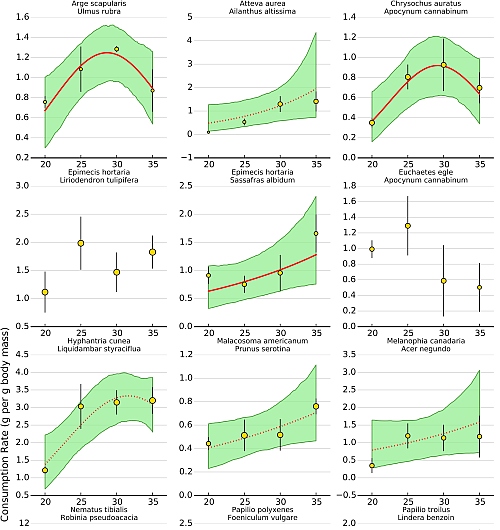
Today’s Interview with an Author is with Nathan Lemoine, PhD candidate in Biology at Florida International University and corresponding author on “Variable effects of temperature on insect herbivory”, an article that we published last week. We were very interested in hearing more about his research on ecology and climate change (incidentally, he has a nice website!), and his experience with us.
PJ: Can you tell us a bit about yourself?
NL: I knew, or thought I knew, in high school that I wanted to be a marine biologist. I took the first opportunity I could get to work in a marine biology lab, joining Malcom Hill’s lab at the University of Richmond. After that, I received a Masters in marine sciences from the Dauphin Island Sea Lab studying coral reefs. I joined Deron Burkepile’s lab at Florida International University to continue studying coral reefs. For a large number of reasons (it’s hard to do field warming experiments under water), I switched to terrestrial systems and now work closely with John Parker at the Smithsonian Environmental Research Center. I am interested in just about everything, but I like to focus on the way temperature regulates species interactions and community structure so that we can understand and hopefully predict how communities will be structured in future climates.
PJ: Can you briefly explain the research you published in PeerJ?

NL: There’s a lot of interest in predicting how climate change, specifically rising temperatures, will influence species interactions. My previous work had shown that temperature affected herbivory by a single generalist herbivore, Popillia japonica, differently for every plant that I fed it. Much of this variation could be explained by plant nutritional content. I wanted to know if there might be some genera, predictable pattern in the way temperature affects herbivory rates based on plant nutritional content. I predicted that rising temperatures might causes increased consumption on low quality diets due to compensatory feeding but would not affect consumption on high quality diets. To test this I fed as many herbivores I could find as many different plants I could get them to eat and measured nutritional quality in all plants. It turns out that every herbivore-plant pair has a unique relationship with temperature that is not related to plant nutrition. There is evidence that, within an herbivore species, plant nutritional content does make a difference, but this has to be tested more rigorously. The take-home message would be that predicting the effects of climate change on plant-herbivore interactions is immensely complicated and we haven’t found a way to make reliable predictions just yet.
PJ: Which figure in the manuscript do you think best summarizes your results?
NL: I think Figure 4 really drives home the main message of the paper: every herbivore does something different, including individuals of the same species eating different plants.
.

Part of Figure 4.
.
PJ: Why did you choose to reproduce the complete peer-review history of your article?
NL: I believe in open science from start to finish for a variety of reasons. Mostly, though, there’s been a lot of attention recently devoted to the lack of reproducibility in experiments, some of which is due to small sample sizes and some of which is due to poor statistical practice. To me, one of the cures is complete transparency, which is why I always post my data and code on my website or in a database. Allowing people to see the peer-review history seemed in keeping with this philosophy and might help what’s now known as post-publication review, where scientists use blogs and other media to critique papers after publication.
PJ: What kinds of lessons do you hope the public takes away from the research?
NL: Life is incredibly complex. We know that climate change will have profound impacts on basic ecological services, but these changes will be very hard to predict. Making accurate predictions in ecology is incredibly difficult for a number of reasons. First, we just don’t have enough information. In my paper, many of the herbivores I used have never been studied before, particularly with respect to temperature and herbivory. It’s nearly impossible to make predictions when you’re missing information for well over half of the members of the community. Second, nature is the quintessential “entangled bank”, wherein every species does something different (even individuals within a species). Even with perfect information, such a system may be too complicated and intricate to distill into simple predictions given a severe disturbance like climate change.
PJ: Where do you hope to go from here?
NL: West
PJ: How would you describe your experience of our submission / review process?
NL: It was pretty fantastic. Submission was easy. I am co-author on another paper in review at PeerJ, and the lead author told me that submitting to PeerJ was “fun”. The reviews were thorough and helpful. I’ll also never argue with a 3 month time from first submission to publication. Also, I will never complain about free color figures. I love color figures.
PJ: Did you get any comments from your colleagues about your publication with PeerJ?
NL: I did have one scientist whom I respect a lot send me an email telling me that he loved the paper. That was a good feeling.
PJ: Would you submit again, and would you recommend that your colleagues submit?
NL: I already have, to both of those questions. I’m co-author on another paper currently in revision, and submission to PeerJ was my suggestion based on the positive experience I’d already had.
PJ: Great to hear! Many thanks for your time!
NL: Any time!
Join thousands of satisfied authors, and experience the future of publishing. Submit your next article to PeerJ or PeerJ PrePrints.

